Tetramorium aculeatum (Mayr)
  Type location Ghana (Macromischa
aculeata, Mayr, 1866a: 507, worker; André, 1889: 224, queen; Mayr,
1902: 292, male) - see below Type location Ghana (Macromischa
aculeata, Mayr, 1866a: 507, worker; André, 1889: 224, queen; Mayr,
1902: 292, male) - see below
junior synonyms
andricum (Tetramorium
aculeatum Mayr subsp. andricum
n., Emery, 1908b: 187,
all forms) from Zaïre, collected at Kisangani [Stanleyville] by
H. Kohl - see http://www.antweb.org/specimenImages.do?name=casent0904857
major (Tetramorium
aculeatum Mayr v. major
n. var., Forel, 1915c: 344, worker) from Zaïre, collected at
St. Gabriel, by Kohl - see http://www.antweb.org/specimenImages.do?code=casent0909119
militaris (Macromischoides
aculeatus Mayr stirps militaris
n. st., Santschi, 1924b: 209, illustrated, worker) from Zaïre,
collected at Basongo by H.
Schouteden - http://www.antweb.org/specimenImages.do?code=casent0913979
pulchellus (Macromischoides
aculeatus Mayr var. pulchellus
n. var., Santschi, 1924b: 208, illustrated,
worker) from Zaïre - see http://www.antweb.org/specimenImages.do?code=rmcaent000017782
rubroflava (Tetramorium
aculeatum Mayr v. rubroflava
n. var., Forel, 1916: 420, worker) from Zaïre, collected at St.
Gabriel, by Kohl - see http://www.antweb.org/specimenImages.do?code=casent0904859
wasmanni (Macromischa wasmanni n.
sp, Forel, 1901d: 300, worker; Mayr, 1902: 292, queen & male) from Zaïre,
Kinshasa [Leopoldville], collected by Wasmann - see http://www.antweb.org/specimenImages.do?name=casent0904858
inermis (Bernard, 1952: 249, worker) from Guinea,
Mt. Nimba, at G'ba, by Lamotte - see http://www.antweb.org/specimenImages.do?code=casent0915426
melanogyne (Santschi, 1923e: 285, worker &
queen) from Congo, Brazzaville, by A. Weiss - see http://www.antweb.org/specimenImages.do?code=casent0913978
viridis (Macromischoides
viridis spec. nov., Weber, 1943c: 367, illustrated, all forms)
from Sudan
zumpti (Macromischoides sp. zumpti n.
sp., Santschi, 1937b: 101,
illustrated, worker) from Cameroun, Kumba, by F. Zumpt,
12-16.x.1935 - see http://www.antweb.org/specimenImages.do?code=casent0913981
unavailable names
abdominalis
(Macromischoides
aculeatus Mayr stirps wasmanni
v. abdominalis n. var.,
Santschi, 1924b: 209, illustrated, worker) from Zaïre,
collected at Kasai, Kondué, by E.
Luja - see http://www.antweb.org/specimenImages.do?code=casent0913982
gladiator (Tetramorium
aculeatum Mayr st. andricum
var. gladiator n. var.,
Santschi, 1919c: 248) from Zaïre,
Congo da Lemba by R. Mayné- http://www.antweb.org/specimenImages.do?code=rmcaent000017783
Unpublished name donisthorpei
by Santschi - see http://www.antweb.org/specimenImages.do?code=casent0913983
all forms known (see Bolton, 1995)  . .
|
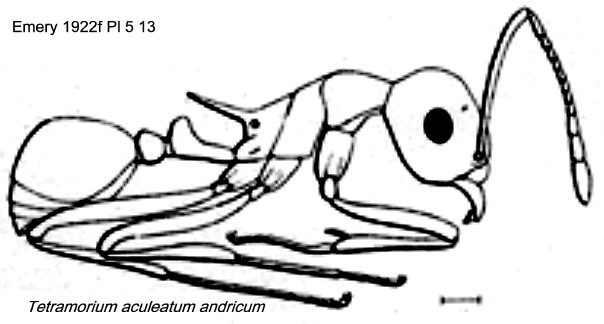 Mayr's (1866a) description is at Mayr's (1866a) description is at  . André's (1889) description of the queen
is at . André's (1889) description of the queen
is at  . Forel's (1901d) description of wasmanni
is at . Forel's (1901d) description of wasmanni
is at  . Mayr's (1902) notes are
at . Mayr's (1902) notes are
at  . Emery's (1908b) description of andricum,
together with his thinking on the species being a Tetramorium
is at . Emery's (1908b) description of andricum,
together with his thinking on the species being a Tetramorium
is at  . Santschi (1910c: 385)
had notes, these are at . Santschi (1910c: 385)
had notes, these are at  . Forel's (1915c) description of major
is at . Forel's (1915c) description of major
is at  . Forel (1916) has further notes and a
description of rubroflava at . Forel (1916) has further notes and a
description of rubroflava at  . Santschi's (1919c) description of gladiator
is at . Santschi's (1919c) description of gladiator
is at  . Santschi's (1923e)
description of melanogyne is at . Santschi's (1923e)
description of melanogyne is at  . Santschi's (1924b) descriptions of pulchellus,
abdominalis and militaris, plus an
illustrated comparison of the propodeum and pedicel forms, and a key to
the varieties, is at . Santschi's (1924b) descriptions of pulchellus,
abdominalis and militaris, plus an
illustrated comparison of the propodeum and pedicel forms, and a key to
the varieties, is at  . .
|
|
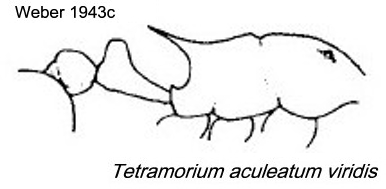 Santschi's
(1937b)
description of zumpti is at Santschi's
(1937b)
description of zumpti is at  . Weber's (1943c) description of viridis
is at . Weber's (1943c) description of viridis
is at  . Bolton's modern
description (1980: 353, illustration only of alitrunk variability and
pedicel) is at . Bolton's modern
description (1980: 353, illustration only of alitrunk variability and
pedicel) is at  . .
Sexuals
|
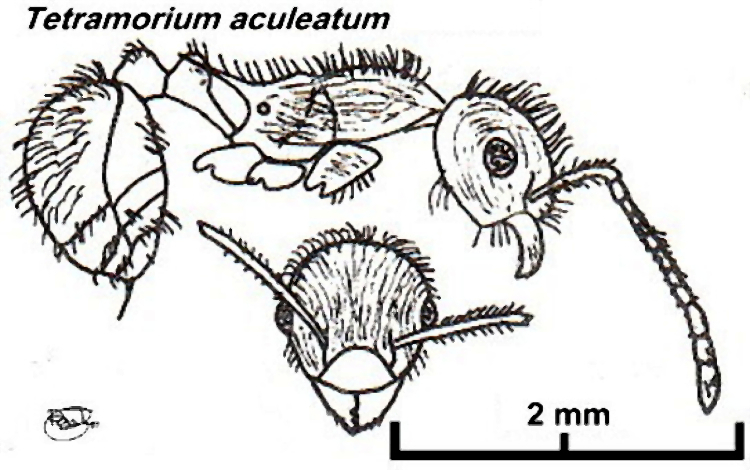 Nigeria
specimens (as Macromischoides aculeatus, Taylor, 1979: 59).
WORKER. Size variable but TL around 4.00-4.40 mm. Larger specimens HL
0.93, HW 0.84, SL 1.17, PW 0.58 Nigeria
specimens (as Macromischoides aculeatus, Taylor, 1979: 59).
WORKER. Size variable but TL around 4.00-4.40 mm. Larger specimens HL
0.93, HW 0.84, SL 1.17, PW 0.58
Colour dark brown but somewhat variable. Sculpturation primarily of
rather sinuous longitudinal rugae on the head, alitrunk and, more
faintly, the pedicel. Abundant erect hairs all over. Mandible denticles
moderately developed. Clypeus near flat, smooth and the margin entire.
Head with a nearly perfect oval shape in full face view; short frontal
carinae, no antennal scrobes. Petiole with a long, narrow, anterior
peduncle. Bolton (1980) described it as a very variable species, that
being the source of the large number of subspecies, strains and
varieties which previously had been described. Thus, the variant
described and illustrated below has to be regarded as aculeatum.
|

Tetramorium aculeatum (Mayr), colour variant
Nigeria specimens (as Macromischoides species
T¹, Taylor, 1979: 61). WORKER. TL 5.29 mm, HL 0.96, HW 1.12, SL 1.28,
PW 0.78
Colour very dark red-brown. Sculpturation rugoreticulate, rugae
dominant, on head and alitrunk, longitudinal except on dorsal pronotum,
where transversely arcuate, and oblique on the lateral mesonotum.
Abundant rather coarse long hairs all over. Mandibles with denticles
much reduced except the apical pair. Clypeus with spiculate central
area and anteriorly marginate. Frontal carinae of head short and no
antennal scrobes. Metanotal groove impressed; propodeum with a
pronounced anterior dorsal carina; propodeal spines noticeably curved
upwards but relatively short when compared to the common T.
aculeatum.
In Nigeria, I collected a single specimen from a vine on a
shade tree in a cocoa plot, Onipe 1/1, Plot C, at the Cocoa Research
Institute of Nigeria, Idi Ayunre. It is very distinctive in appearance
and is larger than the queen of the common T. aculeatum, which
was found on neighbouring cocoa trees. Thus, despite Bolton's
determination of it as aculeatum (personal communication,
1976), it seems to merit the separate treatment and the drawing. In
general the features all fit those described for the larger specimens
by Bolton (1980). An alternative is that it was a specimen of Tetramorium
rimytyum or that rimytyum merits no better status than
that of a variety of aculeatum. Also near the variety major in size and form, but not
colour.
See - Comparison of described varieties
|
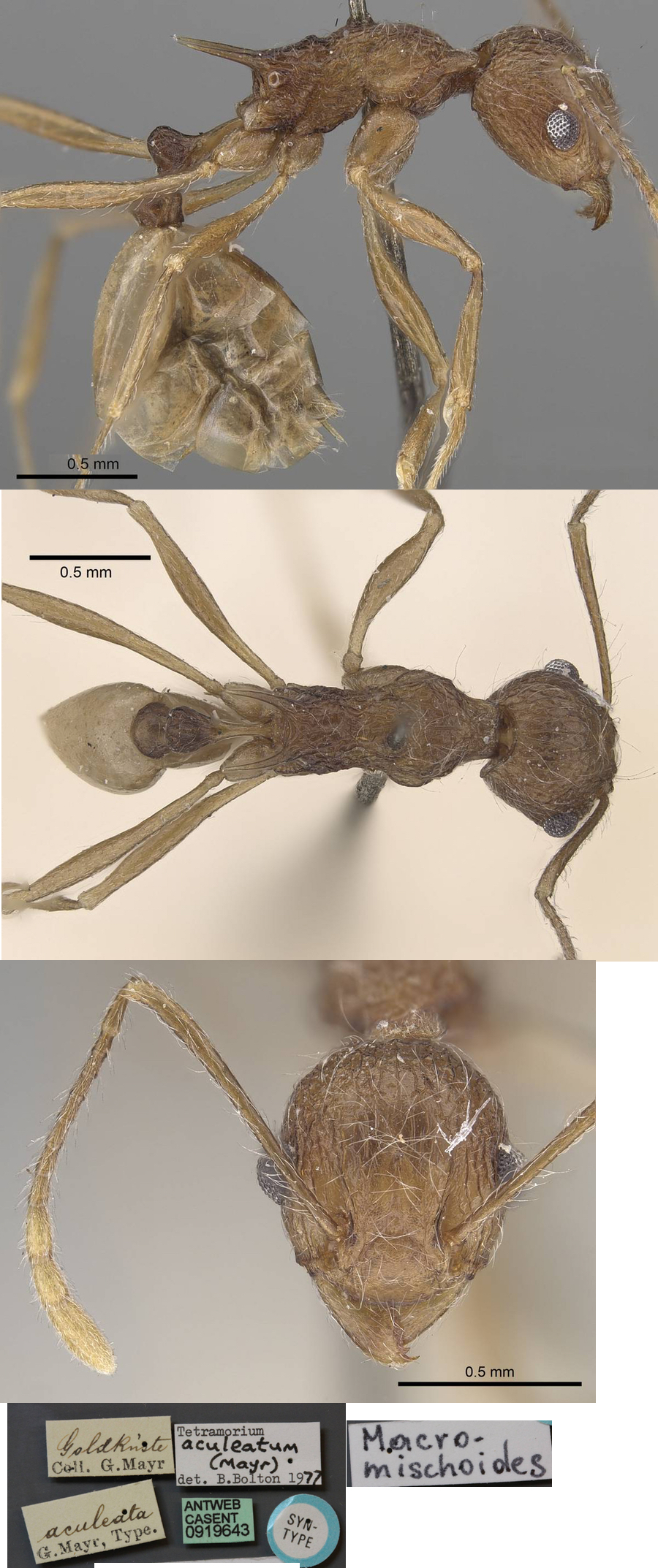 The
photomontage of a syntype worker is collated from http://www.antweb.org/specimen.do?name=casent0919643. The
photomontage of a syntype worker is collated from http://www.antweb.org/specimen.do?name=casent0919643.
|
 Associated worker, queen and male morphs from a single nest in Benin (RVA 2659) Associated worker, queen and male morphs from a single nest in Benin (RVA 2659)
Worker matching the type (above)
|
 The
photomontage is of a queen from Benin, as above. The
photomontage is of a queen from Benin, as above.
|
 The
photomontage is of a male from Benin, as above. The
photomontage is of a male from Benin, as above.
|
Oxford University Museum
specimens
Tetramorium aculeatum
B Taylor det. |
Cameroun
A Fotso Kuate
Tetramorium aculeatum
|
9.v.2007
Awae II
03°54'30" N
11°25'58"
|
Quadrat in fallow
|
1
|
 |
Tetramorium aculeatum
B Taylor det. |
Cameroun
A Fotso Kuate
Sample 47
|
3.ix.2008
Nkolbisson
03°54'30" N
11°25'58"
|
|
2
|
 |
Tetramorium aculeatum
B Taylor det. |
Rep. of Congo
E Vingerhoedt
ex Y Braet
|
xi.2009
Owando
0°28'" S
15°52' E
|
|
2
|
 |
Tetramorium aculeatum
B Taylor det.
Queen
|
Central African
Republic
P Annoyer
NP
|
06.vi.1998
Dzanga-Sangha
02°53’ N
16°15’ E
|
Bayanga-Lidjomba
|
1
|
 |
Tetramorium aculeatum
B Taylor det. |
Central African
Republic
P Annoyer
EU-02
|
06.ii.2005
Dzanga-Sangha
02°50’01.8" N
16°08’13.7" E
|
Camp 3; 17h-18h,
Fauchage et à vu dans petite saline à proximité du camp; 537m asl
|
2
|
|
Tetramorium aculeatum
B Taylor det.
Queen |
Central African
Republic
P Annoyer
GP
|
09.x.2008
Dzanga-Sangha
03°07'06.4" N
16°07'59.2" E
|
373 m; Camp de
transit 1; 18h30-3h; Bord fleuve Sangha
|
1
|
|
Tetramorium aculeatum
B Taylor det.
Queen |
Central African
Republic
P Annoyer
HS
|
10.x.2008
Dzanga-Sangha
03°06'14.6" N
16°08'52.1" E
|
493 m; Camp de
transit 2; 18h30-3h;
Au dessus d'une chute d'eau (ruisseau Songo 1) à proximité du camp
|
1
|
 |
Tetramorium aculeatum
B Taylor det.
Male |
Central African
Republic
P Annoyer
IB
|
13.x.2008
Dzanga-Sangha
03°03'58.3" N
16°08'59.6" E
|
528 m; Camp 1;
17h30-3h;
A la base de l'Ayous (Triplochiton
scleroxylon, Sterculiaceae) à 50 m du Camp
|
1
|
 |
Tetramorium aculeatum
B Taylor det.
Queen |
Central African
Republic
P Annoyer
IC
|
13.x.2008
Dzanga-Sangha
03°03'58.3" N
16°08'59.6" E
|
528 m; Camp 1;
17h30-3h;
A 20 m de l'Ayous (Triplochiton
scleroxylon, Sterculiaceae) dans la forêt
|
1
|
|
Tetramorium aculeatum
B Taylor det.
Male |
Central African
Republic
P Annoyer
IN
|
13.x.2008
Dzanga-Sangha
03°03'58.3" N
16°08'59.6" E
|
528 m; Camp 1;
21h10-3h
Sur plate-forme à 54 m du sol dans un Ayous (Triplochiton scleroxylon,
Sterculiaceae) à 50 m du camp
|
1
|
 |
Tetramorium aculeatum
B Taylor det.
Queen |
Central African
Republic
P Annoyer
IU
|
13.x.2008
Dzanga-Sangha
03°03'58.3" N
16°08'59.6" E
|
528 m; Camp 1;
18h-7h;
A la base de l'Ayous (Triplochiton
scleroxylon, Sterculiaceae) à 50 m du Camp
|
1
|
 |
Tetramorium aculeatum
B Taylor det.
Queen |
Central African
Republic
P Annoyer
Di-03
|
20.i.2005
Dzanga-Sangha
03°55’13.2" N
16°36’46.1" E
|
U.V : 2h-6h, après
Sefka (entre Bambio et croisement Nola/Berberati),
dans layon forestier; from on a reduviid bug;
collected in forest, 1st hour of the morning; 536m asl
|
1
|
 |
Tetramorium aculeatum
B Taylor det.
Male |
Central African
Republic
P Annoyer
Di-03 |
20.i.2005
Dzanga-Sangha
03°55’13.2" N
16°36’46.1" E |
U.V : 2h-6h, après
Sefka (entre Bambio et croisement Nola/Berberati),
dans layon forestier; from on a reduviid bug;
collected in forest, 1st hour of the morning; 536m asl |
1
|
|
Tetramorium aculeatum
B Taylor det. |
Central African
Republic
P Annoyer
EE 06
|
31.i.2005
Dzanga-Sangha
02°49’07.9" N
16°09’28.3" E
|
377m; Camp 2;
prélèvements à 35-40m du sol dans un Azobé (Lophira alata, Ochnaceae), 11h-17h
|
2
|
 |
Tetramorium aculeatum
B Taylor det.
Queen |
Central African
Republic
P Annoyer
LS
|
15.xi.2010
Dzanga-Sangha
2°27'11.6"N
16°04'58.7"E
|
343 m; jour, à vue
derrière le village, Molongo, strate arbustive (Casside land)
|
1
|
 |
Tetramorium aculeatum
B Taylor det.
Queen |
Central African
Republic
P Annoyer
MI
|
19.xi.2010
Dzanga-Sangha
2°28'45.9"N
16°13'15.0"E
|
396 m; nuit, à vue,
au camp de transit 2 (près lac 1)
|
1
|
 |
Tetramorium aculeatum
B Taylor det. |
Central African
Republic
P Annoyer
MP1
|
20.xi.2010
Dzanga-Sangha
2°28'54.1"N
16°13'38.2"E
|
395 m; nuit, équipe
1, UV : 20h-4h, bord lac 2
|
2
|
 |
Tetramorium aculeatum
B Taylor det.
Male |
Central African
Republic
P Annoyer
OT1
|
29.xi.2010
Dzanga-Sangha
2°28'08.6"N
16°13°32.1"E
|
385 m; nuit, équipe
1, UV : 18h30-6h, petite clairière dans forêt à 20 m du bord du lac 5
"AA1"
|
2
|
 |
|
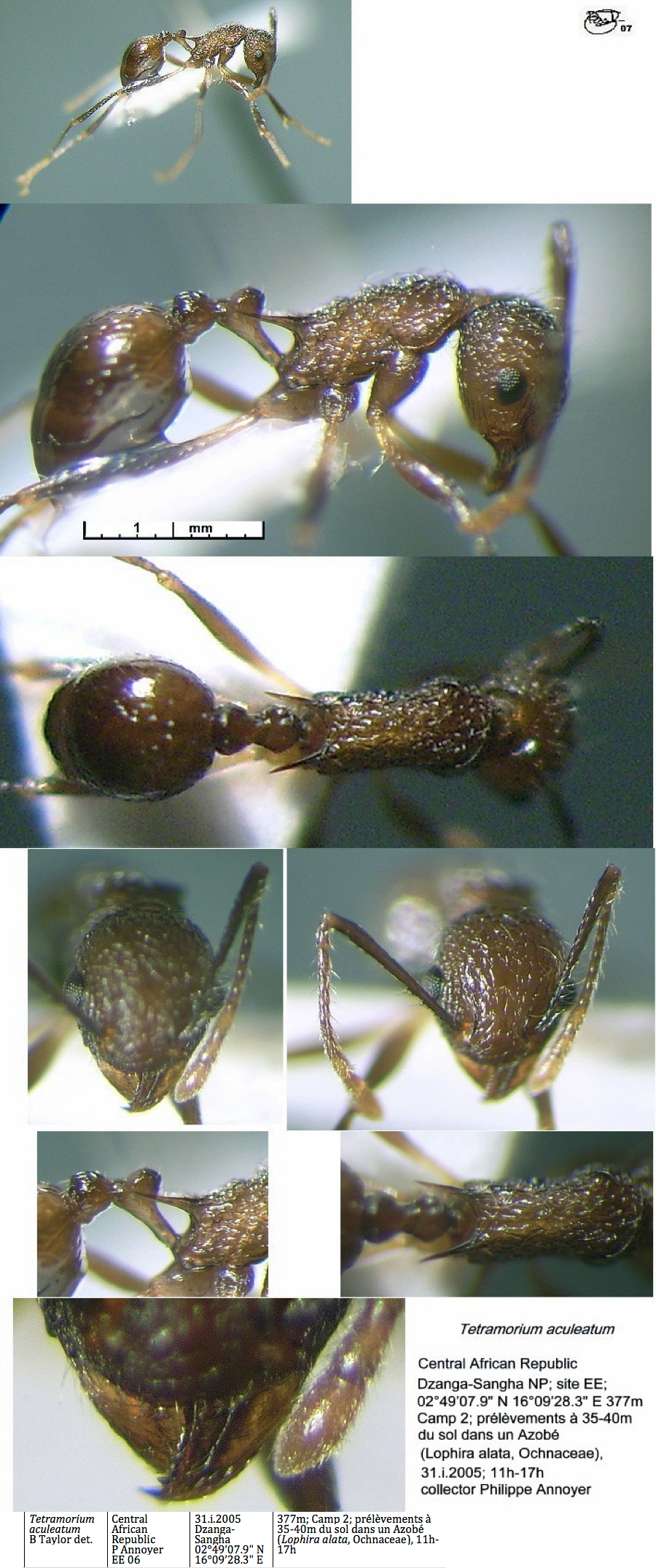 The
photomontage is of a worker from the Central African Republic,
Dzanga-Sangha NP; site EE; collector Philippe Annoyer (CAR Camp 2). The
photomontage is of a worker from the Central African Republic,
Dzanga-Sangha NP; site EE; collector Philippe Annoyer (CAR Camp 2).
|
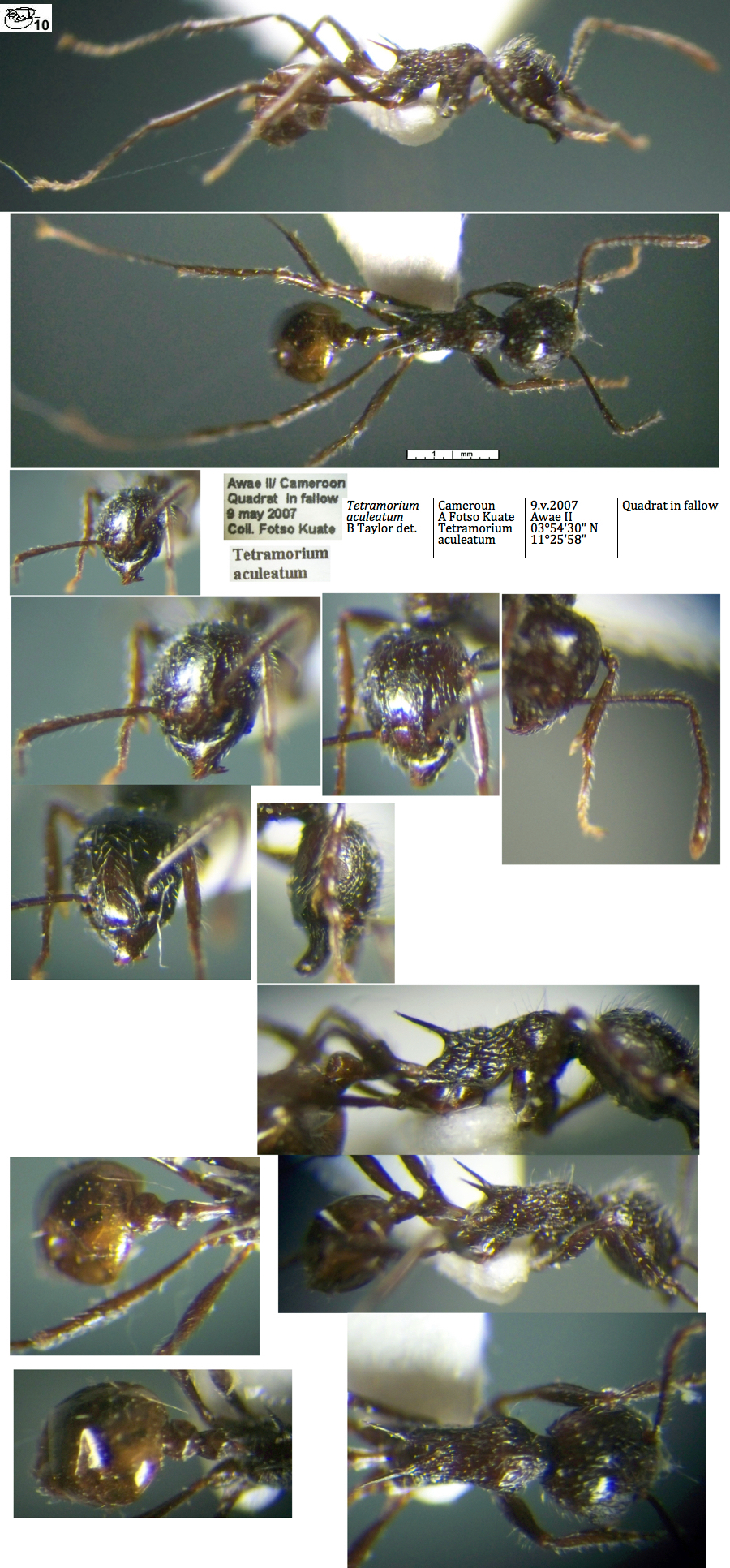 The
photomontage is
of a worker from Cameroun;
Awae II; collector A Fotso Kuate (fk
tetramorium aculeatum). The
photomontage is
of a worker from Cameroun;
Awae II; collector A Fotso Kuate (fk
tetramorium aculeatum).
|
Forel (1909d), reporting specimens from Sankuru, Zaïre,
collected by Luja, noted that his variety wasmanni was a small
form with very short propodeal spines, including on the female. Later
(1915c) he described the variety major - TL 4.2-4.8; black;
appendages and mandibles brown; gaster and pedicel of petiole
red-brown; otherwise as type but simply much larger; from St. Gabriel,
Zaïre, by Kohl, constructing larger more solid nests than wasmanni.
Common throughout West Africa. Wheeler (1922) listed
findings from Guinea (Los Islands, H. Brauns), Sierra Leone
(Mocquerys), Cameroun (Sjöstedt; Abo by R. Buchholz; Victoria,
F. Silvestri; Ekona, by Hintz) and many Congo locations.
|
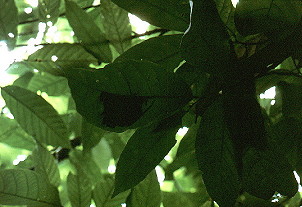 A very widely distributed,
major dominant of closed canopy cocoa, on up to 15% of trees in Nigeria
(Booker, 1968; Taylor, 1977; Taylor & Adedoyin, 1978), and other
tree crops with suitable, large softish leaves on the underside of
which, or between which, the ants build their well-known 'felt' nests
(right, clickable image). Tends Homoptera, including the report by
Adenuga & Adeboyeku (1987) of it attending Pseudococcus
hargreavesi. Also found on native shrubs and trees, and on cashew,
coffee and kola. A very widely distributed,
major dominant of closed canopy cocoa, on up to 15% of trees in Nigeria
(Booker, 1968; Taylor, 1977; Taylor & Adedoyin, 1978), and other
tree crops with suitable, large softish leaves on the underside of
which, or between which, the ants build their well-known 'felt' nests
(right, clickable image). Tends Homoptera, including the report by
Adenuga & Adeboyeku (1987) of it attending Pseudococcus
hargreavesi. Also found on native shrubs and trees, and on cashew,
coffee and kola.
Its biology in Ghana was described by Strickland (1951a, as M. aculeatus),
who noted a negative association with mealybugs and their attendant ant
species. Leston (1973) also regarded
it as a dominant, writing that it needs areas of good dense canopy
cocoa or cocoa under fairly heavy top shade. Later it was collected
from cocoa canopy and herbs under cocoa by Room
(1971) at the Mampong Cemetery farm, plus 19 collections from the
168 samples of insolated cocoa canopy. He described it as a potentially
common dominant which rarely holds a large territory, and established a
negative association with Oecophylla longinoda. Majer (1972) (also as M. aculeatus)
found it to be a clear dominant on cocoa at Kade; he later described
finding it in 70% of his 144 pkd samples at Kade, with around 1500
workers per sample (Majer 1975, 1976a, b, c). Also from cocoa mistletoe
(Room, 1975). Bigger (1981a) recorded
as one of the three most common species on a block of Amelonado cocoa
at CRIG, occupying areas inhabited also by Crematogaster
clariventris and avoiding Oecophylla longinoda. At that
stage Bigger referred to it as a sub-dominant, arguing that it was
inadequately aggressive to counter the true dominants. Later, he seems
to accept it as a true dominant (Bigger, 1993b) and Campbell (1994) argues that it dominates
cocoa lacking in Homoptera. On a wider scale, it was found on leaf
litter, as a 'tourist', at Kade, under cocoa, and the Atewa Forest
Reserve, under primary and secondary forest, by Belshaw & Bolton
(1994b). Strickland (1951a) also described it being found nesting on
kola, plantain and several forest trees, adding that it did not appear
to have any marked host preferences.
Bernard (1952) reporting
the Mt. Nimba survey work in Guinea, noted that curiously few
specimens were collected by Lamotte. The new subspecies "inermis"
was based on 6 workers found on a path at G'ba; the specimens being
close to the race andricum, a small form known from Congo and
Uganda, but the Nimba specimens had the propodeal spines (normally
long) reduced to short teeth. In a footnote, Bernard added that workers
had been sent to him by A. Balachowsky, from a "station lower in
Guinea"; "very aggressive, the workers had a remarkable clavigerid
Coleopteran in their nest".
[E.B. Britton, in Insects of Australia, Melbourne University
Press, 1972, Chapter 30, Coleoptera, has an illustration (p. 546) of
such a beetle, noting "the CLAVIGERINAE (Coleoptera: Pselaphidae) are
specialised for life in ants' nests, having highly modified antennae,
reduced maxillary palps, and trichomes in the form of a hollow or
hollows at the base of the abdomen surrounded by tufts of yellow hair".]
Bernard also reported the collection of two dealated queens of ssp "andricum"
from station B 8-40, N'Zo and Mount Tô at 1600 m; and, a single
yellowish male of "Macromischoides sp." from Zouépo (B6-100),
this had a slimmer thorax, with brown spots and two obtuse epinotal
teeth, he could not be certain if it was a male of inermis, as
the male of andricum was very different.
Jackson (1984) found it
as the dominant on 28-30% of cocoa trees in two study plots at
Nko'emvon in Cameroun. She described how it was negatively
associated with Crematogaster africana, Crematogaster
gabonenis and Oecophylla longinoda but thought its habitat
preference was for thinner canopy - thus differing from the situation
in Ghana and Nigeria. The latter difference she ascribed to perhaps
being a result of opportunity for colonisation and its relations with
the other dominants.
In Liberia it was common on trees at lowland and
upland areas (Carroll, 1979).
|
|